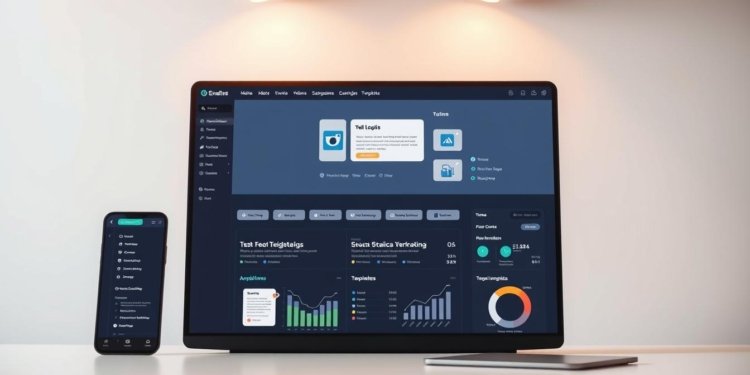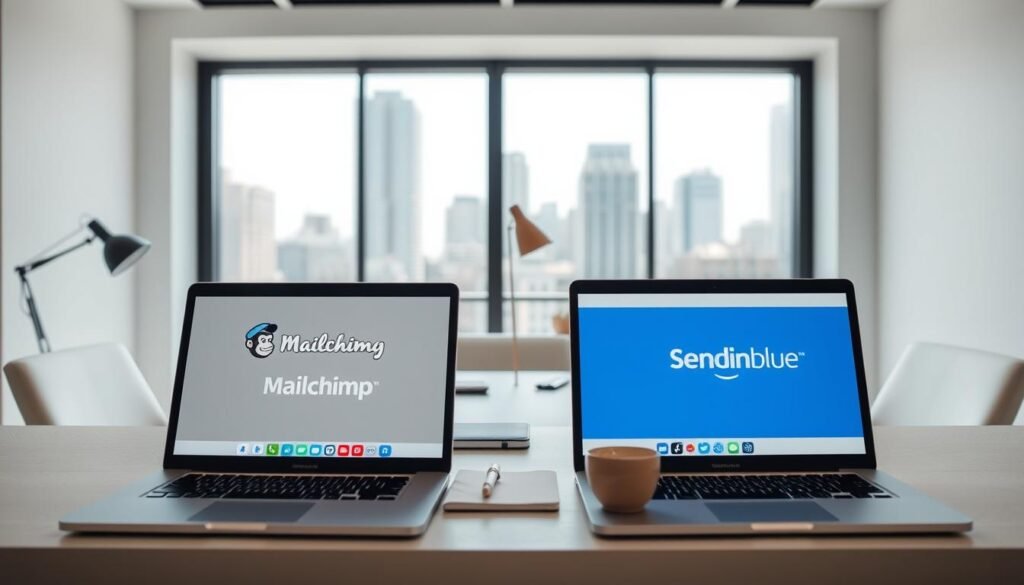Did you know that over 3.1 billion AI-generated emails are sent monthly through one of the most trusted email marketing tools in the world? With more than 11 million users globally, this platform has transformed how businesses connect with their audiences. But what makes it stand out in a crowded market of marketing platforms?
Mailchimp has evolved from a simple email service to a full-fledged marketing automation powerhouse. Over its 22-year journey, it has integrated SMS, AI content tools, and predictive analytics to help businesses achieve a reported 25X ROI. Whether you’re a small business or an enterprise, this platform offers solutions tailored to your needs.
In this guide, we’ll explore its core capabilities, compare it to competitors like Constant Contact and HubSpot, and dive into its security features. Ready to unlock the full potential of email marketing? Let’s get started.
Key Takeaways
- Mailchimp sends over 3.1 billion AI-generated emails monthly.
- It has evolved into a comprehensive marketing platform with SMS integration.
- Users report a 25X ROI on the Standard plan.
- Features include AI content tools and predictive analytics.
- It’s trusted by over 11 million users globally.
Introduction to Mailchimp
What started as a simple e-greeting card service is now a global brand. This marketing platform has become a go-to solution for businesses looking to connect with their audience effectively. With over 11 million users worldwide, it’s trusted by companies of all sizes to drive growth and engagement.
What is Mailchimp?
Mailchimp is an Intuit-owned marketing automation platform designed to help businesses streamline their marketing efforts. It offers tools for email campaigns, landing pages, and ad retargeting, making it a comprehensive solution for small and medium-sized enterprises (SMEs).
History and Evolution of Mailchimp
Founded in 2001 as Rocket Science Group, the platform initially focused on e-greeting cards. In 2009, it introduced a freemium model, rapidly expanding its user base. By 2014, it was sending over 10 billion emails monthly. Today, it’s a full-fledged marketing suite, offering advanced features like AI content tools and predictive analytics.
Notable campaigns, such as the “Serial” podcast sponsorship and the viral “MailKimp” ad, have cemented its place in pop culture. Acquired by Intuit for $12 billion in 2021, it continues to innovate, providing SMEs with the tools they need to succeed.
Mailchimp’s Core Features
With over 300 integrations, this platform offers unmatched versatility for marketers. It provides tools to create engaging campaigns, streamline workflows, and connect with your audience effectively. Let’s dive into its standout features.
Email Marketing Tools
The platform’s drag-and-drop editor makes it easy to design professional email templates. AI content suggestions help craft compelling messages. You can also use A/B testing to optimize subject lines and content for better engagement.
Customizable templates and brand kit functionality ensure consistency across campaigns. Whether you’re creating newsletters or promotional emails, these tools save time and boost results.
Marketing Automation Capabilities
Automation simplifies complex tasks like abandoned cart recovery. Multi-step workflows guide customers through their customer journeys, increasing conversions. Behavioral targeting ensures messages reach the right people at the right time.
Send time optimization and predictive analytics further enhance campaign performance. These features make it easy to deliver personalized experiences at scale.
Advanced Segmentation and Targeting
Reach your audience with precision using demographic and behavioral segmentation. This allows you to tailor messages based on user preferences and actions. The platform’s advanced segmentation tools ensure your campaigns resonate with specific groups.
From landing pages to email campaigns, these features help you create targeted strategies that drive results. Multivariate testing on the Premium plan takes optimization to the next level.
Mailchimp Pricing Plans
From free tiers to enterprise solutions, there’s a plan for every stage of growth. Understanding the pricing structure ensures you choose the right option for your business needs. Let’s explore the available tiers and their features.
Free Plan: Is It Worth It?
The free plan is ideal for startups and small businesses. It allows up to 500 contacts and 2,500 emails per month. While it lacks advanced features, it’s a great way to test the platform’s capabilities.
Essentials Plan: Features and Benefits
This plan unlocks additional tools like email templates and basic automation. It’s perfect for businesses ready to scale their marketing efforts. The plan allows for more contacts and emails, making it a cost-effective choice.
Standard Plan: Advanced Tools for Growing Businesses
For growing businesses, the Standard plan offers advanced features like A/B testing and behavioral targeting. A 15% discount is available, making it an attractive option for those looking to maximize ROI.
Premium Plan: Enterprise-Level Solutions
At $350+ per month for 10,000 contacts, the Premium plan is designed for large enterprises. It includes multivariate testing, advanced segmentation, and priority support. This tier is ideal for businesses needing robust, scalable solutions.
Mailchimp vs. Constant Contact
Choosing the right marketing solution can make or break your campaign’s success. Both Mailchimp and Constant Contact are popular platforms, but they cater to different businesses need. Let’s break down their key differences to help you decide which one fits your goals.
Feature Comparison
When it comes to plan features, both platforms offer robust tools. Mailchimp provides a drag-and-drop editor and AI-driven content suggestions, while Constant Contact excels in event marketing tools and lead capture form customization. Mailchimp’s template library includes 100+ designs, but Constant Contact offers 150+ templates, giving users more creative options.
Mobile app functionality also differs. Mailchimp’s app is user-friendly for campaign management, while Constant Contact focuses on event reminders and attendee tracking. Nonprofits should note that Constant Contact offers specific discounts, making it a cost-effective choice for charitable organizations.
Pricing Structure
Mailchimp’s free plan allows up to 500 contacts and 2,500 emails monthly, but Constant Contact doesn’t offer a free tier. Instead, it provides unlimited email sends, which can be a game-changer for businesses with high-volume needs. Mailchimp’s pricing scales with advanced features, while Constant Contact’s plans are straightforward, focusing on simplicity and value.
User Experience and Support
Customer support is a critical factor. Mailchimp offers 24/7 chat support, ideal for quick troubleshooting. Constant Contact, on the other hand, provides phone support, which many users find more personal and effective. Both platforms have extensive knowledge bases, but Constant Contact’s hands-on approach often wins praise for its responsiveness.
Ultimately, the choice between these two platforms depends on your specific businesses need. If you prioritize advanced automation and AI tools, Mailchimp might be the better fit. For event-focused campaigns and unlimited email sends, Constant Contact could be the ideal marketing solution.
Mailchimp vs. HubSpot
When comparing two leading platforms, the differences in their features become clear. Both offer robust marketing tools, but their approaches to sophisticated automation and integration capabilities vary significantly. Let’s explore how they stack up in key areas.
Marketing Automation Showdown
HubSpot excels in sophisticated automation, offering tools for complex workflows and CRM integration. Its AI-driven content generation helps users craft personalized campaigns effortlessly. Meanwhile, the other platform focuses on simplicity, making it easier for beginners to navigate.
For businesses with advanced needs, HubSpot’s automation depth is unmatched. However, the learning curve can be steep for new users. The platform’s agency partner program also provides additional support for growing businesses.
Integration Capabilities
HubSpot boasts over 1,000 app integrations, far surpassing the 300+ offered by its competitor. This extensive network enhances its integration capabilities, allowing users to connect with a wide range of tools seamlessly.
Whether you’re syncing CRM data or automating sales processes, HubSpot’s ecosystem is more versatile. This makes it a better choice for enterprises with diverse tech stacks.
Customer Support and Resources
HubSpot’s Premium plan includes dedicated phone support, a feature that many users find invaluable. Its comprehensive knowledge base and training resources further enhance the user experience.
On the other hand, the competitor offers 24/7 chat support, which is ideal for quick troubleshooting. Both platforms provide robust resources, but HubSpot’s hands-on approach often wins praise for its responsiveness.
Mailchimp vs. Sendinblue
When it comes to choosing the right email marketing platform, the decision often boils down to features, pricing, and ease of use. Both Mailchimp and Sendinblue offer robust tools, but they cater to different needs. Let’s explore how they stack up in key areas.
Email Marketing Features
Sendinblue stands out with its unlimited contact count, making it ideal for businesses with large lists. It also excels in cold email marketing, offering tools to reach new audiences effectively. On the other hand, Mailchimp’s tiered system limits contact count but provides advanced segmentation for targeted campaigns.
Both platforms offer basic email templates and drag-and-drop editors. However, Sendinblue includes heatmap analytics, giving users insights into email engagement. Mailchimp focuses on AI-driven content suggestions, enhancing message personalization.
Pricing and Plans
Sendinblue’s pricing is based on email sends, starting at $20 for 25,000 emails. This model is cost-effective for businesses with high-volume needs. Mailchimp, however, uses a tiered pricing system based on contact count, which can become expensive as your list grows.
Both platforms offer free plans, but Sendinblue’s free tier includes unlimited contacts, while Mailchimp’s free plan limits you to 500 contacts. For businesses looking for flexibility, Sendinblue’s pricing structure is more appealing.
Ease of Use and Customization
Sendinblue’s interface is intuitive, making it easy for beginners to navigate. Its landing page builder is a standout feature, allowing users to create custom pages without coding. Mailchimp, while user-friendly, has a steeper learning curve due to its advanced features.
Both platforms provide access to GDPR compliance tools, ensuring your campaigns meet legal standards. However, Sendinblue’s focus on simplicity and customization makes it a better choice for businesses prioritizing ease of use.
Optimizing Your Mailchimp Strategy
Maximizing your email marketing efforts requires a strategic approach. Whether you’re running marketing campaigns for a small business or a large enterprise, the right tactics can significantly improve engagement and conversions. Let’s explore how to optimize your strategy for better results.
Best Practices for Email Campaigns
Start by crafting compelling subject lines to grab attention. Use A/B testing to determine what resonates with your audience. Personalization is key—address recipients by name and tailor content to their preferences.
Timing also matters. Top performers use send time optimization, which can boost open rates by 23%. Ensure your emails are mobile-friendly, as most users view messages on their phone.
Leveraging Automation for Better Results
Automation simplifies repetitive tasks and ensures timely communication. Set up drip campaigns to nurture leads over time. For e-commerce businesses, cart recovery automation can recover lost sales.
Cross-channel tactics, like combining SMS and email, can enhance engagement. Automation also allows you to segment your audience into groups based on behavior, ensuring messages are relevant.
Advanced Segmentation Techniques
Segmentation is crucial for delivering personalized experiences. Use predictive segmentation to target users based on their lifecycle stage. This approach can increase conversions by 35%.
Create groups based on demographics, purchase history, or engagement levels. Advanced segmentation ensures your campaigns resonate with specific audiences, driving better results.
Mailchimp for Small Businesses
For small businesses, finding the right marketing tool can be a game-changer. With limited resources, these businesses need solutions that are affordable, easy to use, and effective. The platform’s mailchimp basic features make it a top choice for entrepreneurs looking to grow their brand.
Why It’s a Top Choice
Small businesses often struggle with audience management and campaign scalability. The platform’s free plan allows up to 500 emails monthly, making it ideal for startups. For those ready to scale, the Essentials Plan is chosen by 82% of SMBs due to its cost-effectiveness and additional features.
Local businesses benefit from pre-designed templates tailored for small businesses. These templates save time and ensure professional-looking campaigns. Integration with tools like Google Ads and SEO tools further enhances marketing efforts.
Success Stories and Case Studies
One boutique saw a 140% increase in sales after implementing automation tools. By segmenting their audience and sending personalized messages, they achieved higher engagement and conversions. This success story highlights the platform’s potential for choice businesses.
Social media post scheduling and review management integrations also streamline marketing workflows. These features allow small businesses to focus on growth while maintaining a strong online presence.
Mailchimp for Large Enterprises
Large enterprises require robust solutions to handle complex marketing needs efficiently. With high-volume campaigns and diverse audiences, scalability and advanced tools are essential. The platform’s Premium Plan is designed to meet these demands, offering features tailored for enterprise-level operations.
Scalability and Advanced Features
The Premium Plan allows unlimited audiences, making it ideal for businesses with extensive contact lists. Predictive analytics helps optimize campaigns, ensuring maximum ROI. High-volume senders can also benefit from a dedicated IP, improving deliverability and performance.
Enterprise security protocols, including SOC 2 compliance, ensure data protection. Multi-team collaboration features streamline workflows, enabling seamless coordination across departments. These advanced features make the platform a reliable choice for large-scale operations.
Custom Solutions and Support
Custom API integration support allows enterprises to connect the platform with their existing tech stack. Account health monitoring services provide real-time insights, helping businesses maintain optimal performance. Compliance with industry regulations ensures campaigns meet legal standards.
Dedicated support teams offer personalized assistance, addressing unique challenges faced by large enterprises. Whether it’s troubleshooting or strategic guidance, the platform’s plan allows businesses to scale confidently while maintaining efficiency.
Mailchimp’s Security and Data Breaches
Ensuring data protection is a top priority for any marketing platform. Over the years, the platform has faced challenges but has also implemented robust measures to safeguard user information. Let’s explore its past incidents and current security protocols.
Overview of Past Incidents
In 2022, a breach affected 319 accounts, compromising user data. This incident highlighted the need for stronger security measures. In 2024, a social engineering attack targeted internal tools, further emphasizing the importance of continuous improvement in access controls.
These incidents served as a wake-up call, leading to significant upgrades in the platform’s security infrastructure. The focus shifted to preventing unauthorized access and ensuring data integrity.
Current Security Measures
Today, the platform employs advanced security protocols to protect user data. Two-factor authentication ensures that only authorized users can access accounts. Data encryption standards, such as AES-256, safeguard sensitive information during transmission and storage.
Compliance certifications like GDPR and CCPA ensure that the platform meets global security and privacy standards. Regular security audits and breach response protocols further enhance its ability to protect user data.
OAuth encryption is now a standard feature, providing an additional layer of security for user accounts. These measures demonstrate the platform’s commitment to maintaining trust and providing reliable support to its users.
Conclusion
Email marketing has become a cornerstone for businesses aiming to connect with their audience effectively. With a reported 25X ROI for paid plan users, the platform stands out in a competitive market. Its free trial, offering 500 emails without a credit card, makes it accessible for startups and small businesses.
When compared to competitors, the platform excels in marketing automation and advanced segmentation. These features allow businesses to deliver personalized campaigns that drive engagement and conversions. The pricing structure, while tiered, offers value at every level, from the Essentials Plan to the Premium Plan.
Looking ahead, AI-driven features are expected to enhance the platform’s capabilities further. For new users, a quick implementation checklist includes setting up automation workflows, segmenting your audience, and leveraging A/B testing for optimal results.
For those exploring alternatives, platforms like Constant Contact and HubSpot offer unique features that may better suit specific business needs. However, for comprehensive email marketing solutions, this platform remains a top choice for businesses of all sizes.
FAQ
What is Mailchimp?
Mailchimp is an email marketing tool designed to help businesses create, send, and track email campaigns. It offers features like templates, automation, and audience segmentation to enhance marketing efforts.
Does Mailchimp offer a free plan?
Yes, Mailchimp provides a free plan that includes basic email marketing tools. It allows up to 500 contacts and 1,000 email sends per month, making it ideal for small businesses or startups.
How does Mailchimp compare to Constant Contact?
Mailchimp and Constant Contact both offer robust email marketing tools, but Mailchimp stands out with its advanced segmentation and automation features. Constant Contact, however, provides more personalized phone support.
What are the key features of Mailchimp’s Standard Plan?
The Standard Plan includes advanced tools like sophisticated automation, customer journeys, and detailed analytics. It’s designed for growing businesses that need more than basic email marketing capabilities.
Is Mailchimp suitable for large enterprises?
Yes, Mailchimp’s Premium Plan offers enterprise-level solutions, including advanced segmentation, custom branding, and priority support. It’s scalable for businesses with complex marketing needs.
How does Mailchimp ensure data security?
Mailchimp employs robust security measures, including encryption, regular audits, and compliance with data protection regulations. While past incidents have occurred, the platform has strengthened its security protocols.
Can I use Mailchimp for landing pages?
Yes, Mailchimp allows users to create and customize landing pages. This feature helps businesses capture leads and grow their audience effectively.
What makes Mailchimp a top choice for small businesses?
Mailchimp’s user-friendly interface, free plan, and scalable pricing structure make it an ideal choice for small businesses. Its advanced tools and automation capabilities also support growth and efficiency.
Does Mailchimp offer phone support?
Mailchimp provides phone support for Premium Plan users. Other plans include email and chat support, along with a comprehensive knowledge base for self-help.
How does Mailchimp’s pricing structure work?
Mailchimp’s pricing is based on the number of contacts and the features you need. Plans range from Free to Premium, with each tier offering additional tools and capabilities to suit different business sizes.








